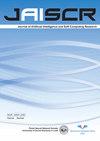Bending Path Understanding Based on Angle Projections in Field Environments
IF 2.4
3区 计算机科学
Q2 COMPUTER SCIENCE, ARTIFICIAL INTELLIGENCE
Journal of Artificial Intelligence and Soft Computing Research
Pub Date : 2023-12-01
DOI:10.2478/jaiscr-2024-0002
引用次数: 0
Abstract
Abstract Scene understanding is a core problem for field robots. However, many unsolved problems, like understanding bending paths, severely hinder the implementation due to varying illumination, irregular features and unstructured boundaries in field environments. Traditional three-dimensional(3D) environmental perception from 3D point clouds or fused sensors are costly and account poorly for field unstructured semantic information. In this paper, we propose a new methodology to understand field bending paths and build their 3D reconstruction from a monocular camera without prior training. Bending angle projections are assigned to clusters. Through compositions of their sub-clusters, bending surfaces are estimated by geometric inferences. Bending path scenes are approximated bending structures in the 3D reconstruction. Understanding sloping gradient is helpful for a navigating mobile robot to automatically adjust their speed. Based on geometric constraints from a monocular camera, the approach requires no prior training, and is robust to varying color and illumination. The percentage of incorrectly classified pixels were compared to the ground truth. Experimental results demonstrated that the method can successfully understand bending path scenes, meeting the requirements of robot navigation in an unstructured environment.基于实地环境中的角度投影理解弯曲路径
摘要 场景理解是野外机器人的核心问题。然而,由于野外环境中的光照变化、不规则特征和非结构化边界,许多尚未解决的问题,如理解弯曲路径,严重阻碍了实施。传统的三维(3D)环境感知来自三维点云或融合传感器,不仅成本高昂,而且对野外非结构化语义信息的考虑不足。在本文中,我们提出了一种新方法来理解野外弯曲路径,并通过单目摄像头建立其三维重建,而无需事先进行训练。弯曲角度投影被分配到集群中。通过其子簇的组合,用几何推理估算出弯曲表面。弯曲路径场景是三维重建中的近似弯曲结构。了解倾斜梯度有助于导航移动机器人自动调整速度。该方法基于来自单目摄像头的几何约束,无需事先训练,对不同颜色和光照具有鲁棒性。错误分类像素的百分比与地面实况进行了比较。实验结果表明,该方法能成功理解弯曲路径场景,满足了机器人在非结构化环境中导航的要求。
本文章由计算机程序翻译,如有差异,请以英文原文为准。
求助全文
约1分钟内获得全文
求助全文
来源期刊

Journal of Artificial Intelligence and Soft Computing Research
COMPUTER SCIENCE, ARTIFICIAL INTELLIGENCE-
CiteScore
7.00
自引率
25.00%
发文量
10
审稿时长
24 weeks
期刊介绍:
Journal of Artificial Intelligence and Soft Computing Research (available also at Sciendo (De Gruyter)) is a dynamically developing international journal focused on the latest scientific results and methods constituting traditional artificial intelligence methods and soft computing techniques. Our goal is to bring together scientists representing both approaches and various research communities.
 求助内容:
求助内容: 应助结果提醒方式:
应助结果提醒方式:


